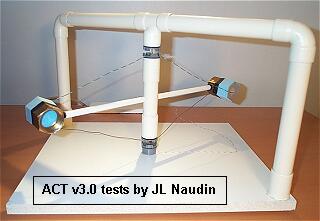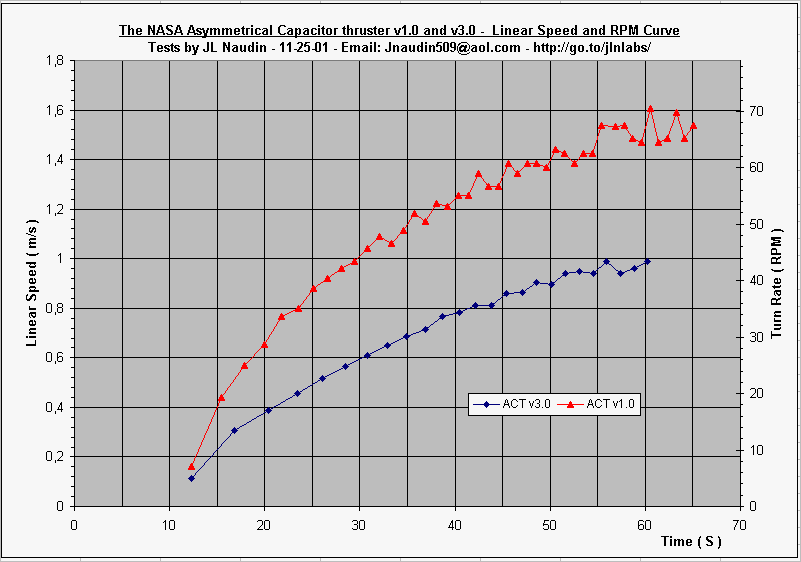

The Asymmetrical Capacitor Thruster v3.0
By Jean-Louis
Naudin
created on
November 18th, 2001 - JLN Labs
- Last update November 26th, 2001
All informations in this page are published free and
are intended for private/educational purposes and not for
commercial applications
This experiment is the continuation of the NASA Asymmetrical Capacitor Thruster ( ACT ) tests, that I have started on Nov 18, 2001. The first version was the successful replication of the original design built and tested by Transdimensionnal Technologies at the Marshall Space Flight Center in a vacuum chamber and patented by the NASA ( patent US 6,317,310 " Apparatus and Method for generating a thrust using a two dimensional asymmetrical capacitor module " granted on Nov 13, 2001 ). The second version tested on Nov 22, 2001 was a personnal attempt to increase the thrust by using a bigger and lighter asymmetrical capacitor made with a thin aluminum tube. This attempt was a failure and I have not been able to get a full turn rotation in spite of many unsuccessful tries. The thrust of the ACT v2.0 wasn't sufficient to overcome the mechanical frictions of the rotor.
WHY was the ACT v2.0 observed thrust so weak ? I think that the lower mass of the main armature of the ACT v2.0 was responsible of this failure. There was less conductive material ( less conductive atoms ) subject to the Electrogravitics effect and thus, in spite of a bigger size of the capacitor, the thrust wasn't sufficient to overcome the friction of the rotor.
So, after some thinkings, I have decided to build a device bigger but heavier than the ACT v1.0.
ACT v3.0 : The new design specifications are :
Main armature
:
- A Brass Nut ( 45 mm wide, 42 mm inner diam and 28mm
length ).
Dielectric
:
- A Polystyrene "Roofmat"
cylinder block ( 45 mm diam and 40 mm length )
Secundary
armature :
- an hexagonal aluminum plate 45 mm wide and 0.5 mm
thick.
Weight : 135 g ( each )
The photo below shows the three versions of the ACT units already tested :

Experiment : I have used the same rotating apparatus and the same High Voltage generator for conducting this test.


The two asymmetrical capacitors are
made with a big hexagonal brass nut, an hexagonal Polystyrene "Roofmat"
block for the dielectric and an hexagonal aluminum disk.
The capacitors are fixed on a 440 mm
diameter frictionless rotor, and the HV is sent through the main
rotation axis.

TESTS RESULTS ( 11-22-01 ) : Successful
When the HV power supply ( 31 KV DC @ 66uA ) is switched on, the ACT v3.0 starts to rotate and accelerates. You will find below the curves of the Linear speed ( m/s ) and the RPM Vs the time of the ACT v1.0 ( 40 g weight ) and ACT v3.0 ( 135 g weight ).

The detailled analysis of the experimental datas is shown below :
| ACT v1.0 | ACT v3.0 | v3.0 Vs v1.0 | |
Thruster Weight ( Kg ) |
0.04 |
0.135 |
3.4 more |
Initial Acceleration ( m.s-2 ) |
0.088 |
0.043 |
2.0 less |
Thrust ( mN ) |
3.5 |
5.8 |
1.7 more |
HV Power Output ( W ) |
1.74 |
2.05 |
1.2 more |
Thrust (mN) / Power (W) |
2.0 |
2.8 |
1.4 more |

Conclusion : You may notice in the datas above, that if the weight of the main armature is 3.4 more, the thrust increases of a factor 1.7 and also that the Thrust/Power ratio increases of a factor 1.4.
This experiment confirms definitely that the mass of the conductive armature contributes to give more thrust. The Electrogravitics thrust is directly linked to the mass and the volume ( to the number of conductive atoms ) of the main armature.
The shape of the main armature and the surfaces ratio between the small armature ( disk ) and the main armature have also a major role in the thrust observed ( see the test results of the ACT v4.0 ).
See the video of ACT v3.0 tests
To see the videos, the free
downloadable RealPlayer is required ![]()

Click on the
picture above to see the video ( 753 Kb )
Documents references :
The Transdimensional Technologies web site
![]() Read the NASA
Patent description
and see the FULL NASA PATENT US 6,317,310 ( granted November 13, 2001 )
Read the NASA
Patent description
and see the FULL NASA PATENT US 6,317,310 ( granted November 13, 2001 )
NASA MFS 31419_1 -
Apparatus & Method for Generating Thrust Using a Two
Dimensional, Asymmetrical Capacitor;
See also :
![]() Email : JNaudin509@aol.com
Email : JNaudin509@aol.com
Return to the Lifters experiments page